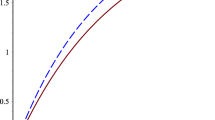Abstract
In this paper, we study intensity of jumps in the context of functional linear processes. The natural space for that is the space D = D[0, 1] of cadlag real functions. We begin with limit theorems for ARMA D(1,1) processes. It appears that under some conditions, the functional linear process and its innovation have the same jumps. This nice property allows us to focus on the case of i.i.d. D-valued random variables. For such variables, we estimate the intensity of jumps in various situations: fixed number of jumps, random instants of jumps, random number of instants of jumps, etc. We derive exponential rates and limits in distribution.
Similar content being viewed by others
References
A. Antoniadis, X. Brossat, J. Cugliari, and J.-M. Poggi, “Prévision d’un processusà valeurs fonctionnelles en présence de non stationnarités. Applicationà la consommation d’électricité”, J.SFdS 153(2), 52–78 (2012).
P. Besse, H. Cardot, and D. Stephenson, “Autoregressive Forecasting of Some Climatic Variation”, Scandinavian J. Statist. 27(4), 673–687 (2000).
P. Billingsley, Convergence of Probability Measures, 2nd ed. in Wiley Series in Probab. and Statist.: Probab. and Statist. (Wiley, New York, 1999).
D. Blanke and D. Bosq, “Observing Jumps in Discrete Time. Applications”, (2014) (in press).
M. Bloznelis and V. Paulauskas, “On the Central Limit Theorem in D[0, 1]”, Statist. Probab. Lett. 17(2), 105–111 (1993).
D. Bosq, “Estimating and Detecting Jumps. Applications to D[0,1]-Valued Linear Processes”, in Festschrift in Honor of Paul Deheuvels (Springer, 2014) (in press).
R. C. Bradley, Introduction to Strong Mixing Conditions (Kendrick Press, Heber City, UT, 2007), Vols. 1–3.
H. Cardot, “Convergence du lissage spline de la prévision des processus autorégressifs fonctionnels”, C. R. Acad. Sci. Paris Sér. I Math. 326(6), 755–758 (1998).
R. Cont and P. Tankov, Financial Modelling with Jump Processes in Chapman & Hall/CRC Financial Mathematics Series (Chapman & Hall/CRC, Boca Raton, FL, 2004).
P. Z. Daffer and R. L. Taylor, “Laws of large numbers for D[0, 1]”, Ann. Probab. 7(1), 85–95 (1979).
J. Damon and S. Guillas, “Estimation and Simulation of Autoregressive Hilbert Processes with Exogenous Variables”, Statist. Inference Stoch. Process. 8(2), 185–204 (2005).
R. Descartes, La Géométrie, Livre Troisième (Jan Maire, Leyden, 1637).
L. El Hajj, “Théorèms limites pour les processus autorégressifsà valeurs dans D[0, 1]”, C. R. Math. Acad. Sci. Paris 349(13–14), 821–825 (2011).
L. El Hajj, Théorèmes limites pour les processus autorégressifs à valeurs dans D[0, 1], Ph.D. Thesis (Université Paris 6, Paris, 2013).
F. Ferraty and P. Vieu, Nonparametric Functional Data Analysis. Theory and Practice, in Springer Series in Statistics (Springer, New York, 2006).
S. M. Garba, A. B. Gumel, and M. R. Abu Bakar, “Backward Bifurcations in Dengue Transmission Dynamics”, Math. Biosci. 215(1), 11–25 (2008).
V. Jacq, P. Albert, and R. Delorme, “Le mistral. Quelques aspects des connaissances actuelles”, La météorologie 50, 30–38 (2005).
V. Kargin and A. Onatski, “Curve Forecasting by Functional Autoregression”, J. Multivar. Anal. 99(10), 2508–2526 (2008).
J. M. Marion and B. Pumo, “Comparaison des modèles ARH(1) et ARHD(1) sur des données physiologiques”, Ann. I.S.U.P. 48(3), 29–38 (2004).
A. Mas, “Consistance du prédicteur dans le modèle ARH(1): le cas compact”, Ann. I.S.U.P. 48(3), 39–48 (2004).
T. Mourid, “Estimation and Prediction of Functional Autoregressive Processes”, Statistics 36(2), 125–138 (2002).
V. Y. Pan, “Solving a Polynomial Equation: Some History and Recent Progress”, SIAM Rev. 39(2), 187–220 (1997).
W. R. Pestman, “Measurability of Linear Operators in the Skorokhod Topology”, Bull. Belg. Math. Soc. Simon Stevin 2(4), 381–388 (1995).
B. Pumo, “Prediction of Continuous Time Processes by C [0,1]-Valued Autoregressive Process”, Statist. Inference Stoch. Process. 1(3), 297–309 (1998).
M. D. Ruiz-Medina, “Spatial Functional Prediction from Spatial Autoregressive Hilbert Processes”, Environmetrics 23(1), 119–128 (2012).
A. N. Shiryaev, Probability, 2nd ed. in Graduate Texts in Mathematics (Springer-Verlag, New York, 1996), Vol. 95.
P. Tankov and E. Voltchkova, “Jump-Diffusion Models: a Practitioners Guide”, Banque et Marchés 99, 1–24 (2009).
Author information
Authors and Affiliations
Corresponding author
About this article
Cite this article
Blanke, D., Bosq, D. Exponential bounds for intensity of jumps. Math. Meth. Stat. 23, 239–255 (2014). https://doi.org/10.3103/S1066530714040012
Received:
Accepted:
Published:
Issue Date:
DOI: https://doi.org/10.3103/S1066530714040012




